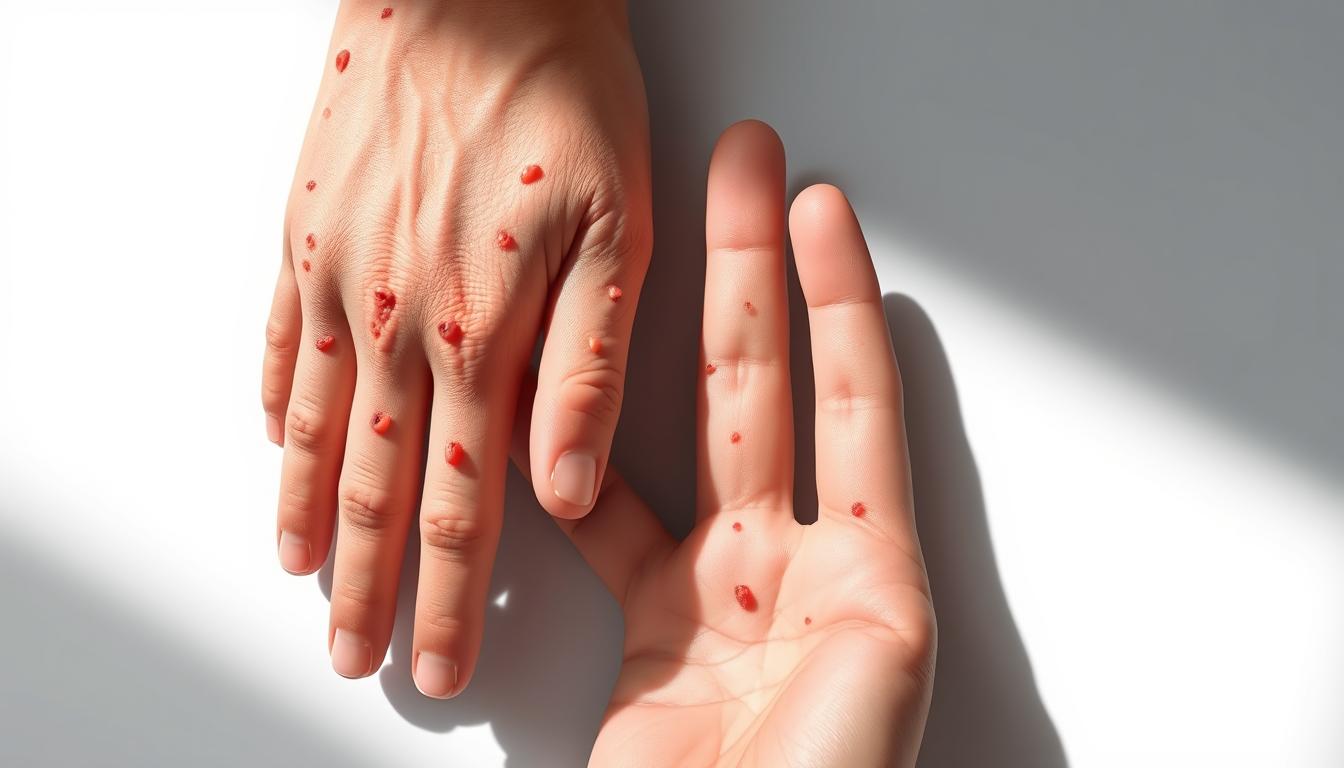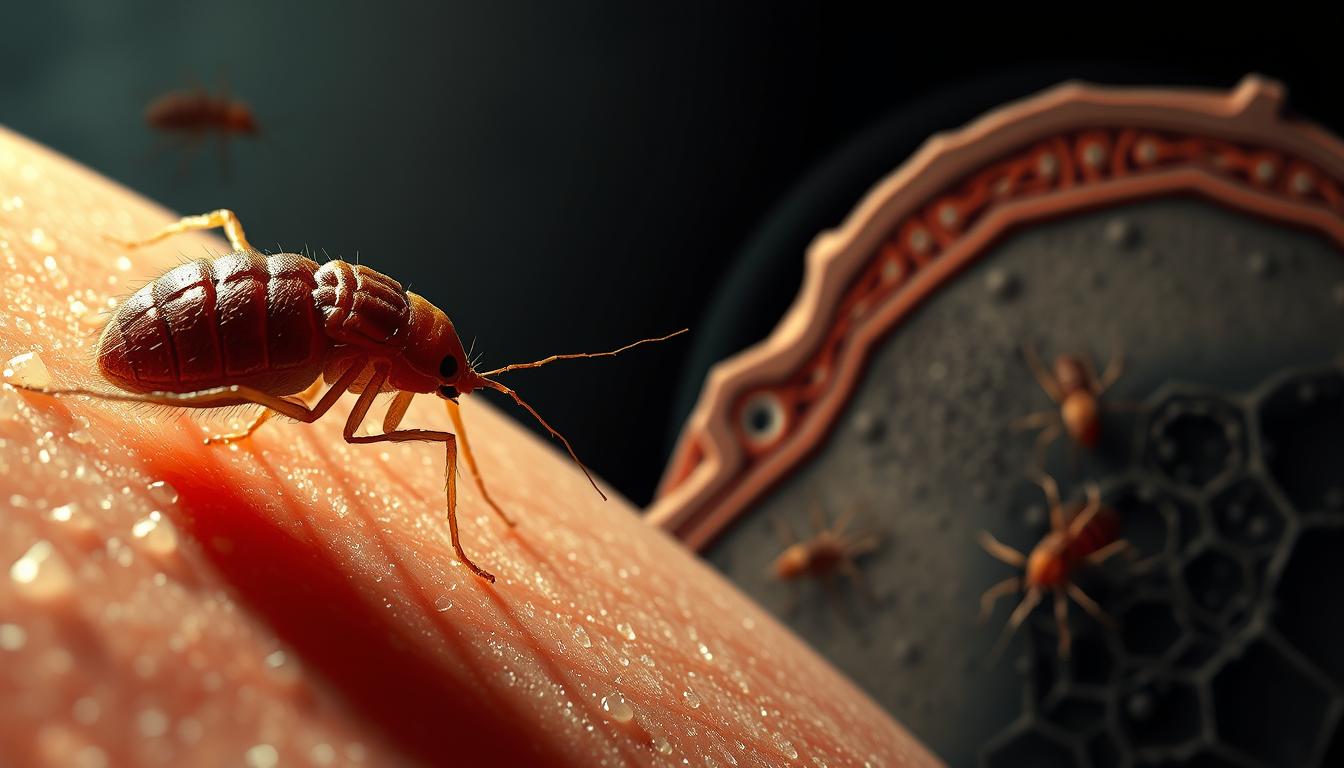Scabies Explained: Recognizing and Treating This Skin Condition
Scabies is a common skin disease caused by a tiny mite that burrows into the skin, leading to intense itching and discomfort. It's highly contagious and can spread through direct skin-to-skin contact.

People affected by scabies often experience scabies symptoms such as redness, rash, and severe itching, especially at night. This condition can significantly impact daily life, making it essential to understand how to identify and manage it.
Key Takeaways
- Scabies is caused by a tiny mite that burrows into the skin.
- It's highly contagious and spreads through direct skin-to-skin contact.
- Common symptoms include intense itching, redness, and rash.
- Scabies can significantly impact daily life due to discomfort.
- Understanding scabies symptoms is crucial for effective management.
What Is Scabies? Understanding the Basics
The scabies mite infestation is a common problem that can affect anyone, regardless of their hygiene habits. Scabies is not a result of poor cleanliness, but rather it's caused by coming into contact with the Sarcoptes scabiei mite.
Definition and Cause of Scabies
Scabies is a skin condition caused by the Sarcoptes scabiei mite, which burrows into the upper layer of human skin. This mite lays eggs, leading to an allergic reaction that causes intense itching and a rash. The mites, their eggs, and their feces are the primary causes of the symptoms associated with scabies.
How Scabies Spreads
Scabies is highly contagious and spreads through direct skin-to-skin contact with an infected person. It can also be transmitted by sharing personal items like clothing, bedding, or towels that have come into contact with an infected individual.

Common Misconceptions About Scabies
One common misconception about scabies is that it's associated with poor hygiene. However, anyone can get scabies, regardless of their cleanliness. Another misconception is that scabies is only a problem in developing countries; it can occur anywhere in the world.
Understanding the facts about scabies is crucial for effective treatment and prevention. By recognizing how scabies spreads and addressing common misconceptions, we can better manage and treat this condition.
How to Recognize and Treat Scabies: A Skin Infection
Recognizing scabies can be challenging due to its similarity to other skin conditions, but understanding its distinct symptoms is crucial for effective treatment. Scabies is a skin infestation caused by the mite Sarcoptes scabiei, leading to intense itching and a characteristic rash.
Common Symptoms and Signs
The most common symptoms of scabies include intense itching, particularly at night, and a pimple-like rash. The itching is a result of the body's allergic reaction to the mites, their eggs, and their waste. The rash often appears as small, raised red bumps or blisters.
Where Symptoms Typically Appear
Scabies symptoms typically appear in specific areas of the body, such as between the fingers, wrists, armpits, and around the waist. In infants and young children, symptoms may also appear on the scalp, face, and neck.
Differentiating Scabies from Other Skin Conditions
Differentiating scabies from other skin conditions can be challenging due to the similarity in symptoms. However, the presence of burrow tracks, which are small, raised lines on the skin where the mites have burrowed, is a distinctive sign of scabies. Other conditions, such as eczema or dermatitis, may present similar symptoms but lack these burrow tracks.
When to See a Doctor
If you experience persistent itching and a rash, especially if it's accompanied by burrow tracks, it's essential to seek medical attention. A doctor can diagnose scabies through a physical examination and may perform a skin scraping to confirm the presence of mites or their eggs.
Prompt treatment is crucial to prevent complications and reduce the risk of spreading the infestation to others. By understanding the symptoms and signs of scabies, you can take the first step towards effective management and treatment.
Effective Treatment Options for Scabies
Treating scabies effectively requires a multi-faceted approach that includes accurate diagnosis, appropriate medication, and thorough environmental cleaning. Scabies, a skin infestation caused by the itch mite, demands a comprehensive treatment plan to eliminate the mites and alleviate symptoms.
Medical Diagnosis Process
Diagnosing scabies typically involves a physical examination by a healthcare professional, who will look for characteristic signs such as burrows, rash, or intense itching, especially at night. In some cases, a skin scraping may be performed to confirm the presence of mites or eggs. This step is crucial for ruling out other skin conditions that may mimic scabies.
Prescription Medications and Their Application
The primary treatment for scabies involves the use of prescription medications, with permethrin cream being a first-line treatment. It is applied from the neck down to all areas of the body and left on for 8-14 hours before being washed off. Ivermectin, an oral medication, is another effective option, especially for those who cannot tolerate topical treatments or have failed other treatments.
Managing Itching and Discomfort
Managing the itching and discomfort associated with scabies is crucial for the patient's quality of life. Antihistamines or hydrocortisone cream can provide relief from itching. Additionally, applying cool compresses or taking oatmeal baths can soothe the skin and reduce irritation.
Environmental Cleaning and Decontamination
To prevent re-infestation, it's essential to thoroughly clean and decontaminate the environment. This includes washing clothing, bedding, and towels in hot water and drying them on a hot setting. Items that cannot be washed should be sealed in a plastic bag for at least 72 hours. Vacuuming furniture and carpets, especially areas where the infested person has been, is also recommended.
By following this comprehensive approach to scabies treatment, individuals can effectively eliminate the infestation and prevent future occurrences.
Special Considerations for Different Populations
Scabies affects different populations in unique ways, requiring tailored approaches to diagnosis and treatment. This variability underscores the importance of understanding the distinct characteristics of scabies infestations across different demographic groups.
Scabies in Children and Infants
Scabies in children and infants presents distinct challenges. Infants and young children are more likely to experience widespread infestations, and their symptoms can be more severe. Treatment must be gentle to avoid irritating their sensitive skin, and it's crucial to treat the entire family to prevent re-infestation.
Crusted (Norwegian) Scabies in Immunocompromised Patients
Crusted scabies, also known as Norwegian scabies, is a more severe form of the infestation that occurs in immunocompromised individuals. These patients have a higher mite burden, making them highly contagious. Treatment is more complex and often requires a combination of topical and oral medications.
Managing Scabies Outbreaks in Households and Institutions
Managing scabies outbreaks in households and institutions requires a coordinated effort. It's essential to treat all members simultaneously and to thoroughly clean and decontaminate the environment to prevent re-infestation. This includes washing clothing and bedding in hot water and drying them on a hot setting.
Potential Complications if Left Untreated
If scabies is left untreated, it can lead to secondary bacterial infections, such as impetigo or cellulitis. In severe cases, these infections can spread to other parts of the body, leading to more serious health issues. Prompt treatment is essential to prevent these complications.
Conclusion: Prevention and Long-term Management
Understanding scabies symptoms and causes is crucial for effective prevention and management. We have discussed how scabies spreads, its common symptoms, and the various treatment options available.
To prevent re-infestation, it's essential to maintain vigilance and adhere to proper hygiene practices. This includes washing clothing and bedding in hot water, drying them on a hot setting, and avoiding direct contact with anyone infected.
Long-term management involves recognizing the causes of scabies and taking proactive steps to prevent future outbreaks. By being aware of scabies symptoms and taking prompt action, we can reduce the risk of complications and maintain healthy skin.
FAQ
What are the common symptoms of scabies?
We experience intense itching, especially at night, and a pimple-like rash. The itching is caused by the body's allergic reaction to the mites, their eggs, and their waste.
How is scabies diagnosed?
We diagnose scabies through a physical examination, medical history, and sometimes a skin scraping to look for mites, eggs, or feces.
What is the treatment for scabies?
We treat scabies with prescription medications, such as permethrin cream or ivermectin. It's essential to follow the treatment instructions carefully and to treat all household members simultaneously.
How can we manage itching and discomfort caused by scabies?
We can manage itching and discomfort with antihistamines, cool compresses, or oatmeal baths. In some cases, we may need to use topical corticosteroids to reduce inflammation.
Can scabies be treated in children and infants?
Yes, we can treat scabies in children and infants, but we need to use gentle treatments and consult a doctor for guidance on the best treatment options.
How can we prevent re-infestation of scabies?
We can prevent re-infestation by washing and drying clothing, bedding, and towels in hot water, drying cleaning, and sealing in plastic bags items that can't be washed.
What are the potential complications if scabies is left untreated?
If left untreated, scabies can lead to secondary bacterial infections, such as impetigo, and potentially more severe conditions like kidney disease or rheumatic fever.